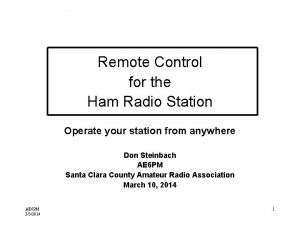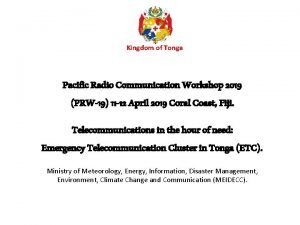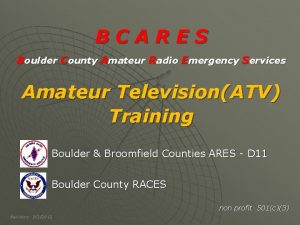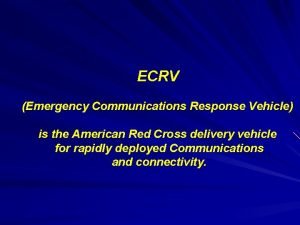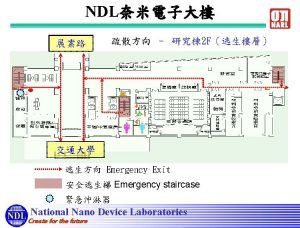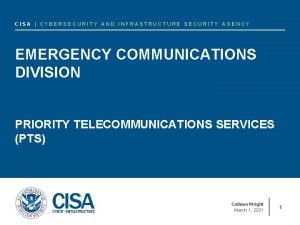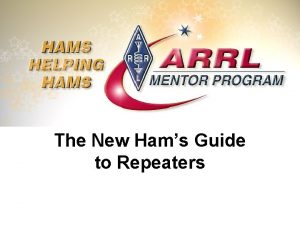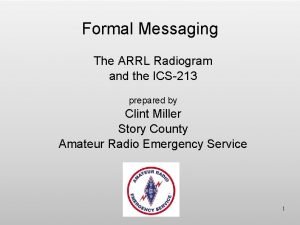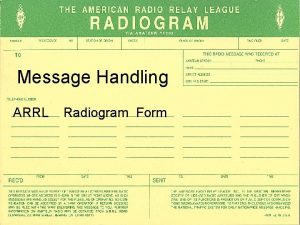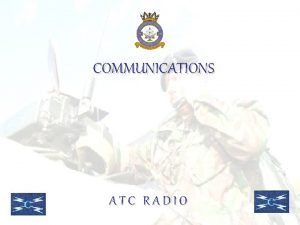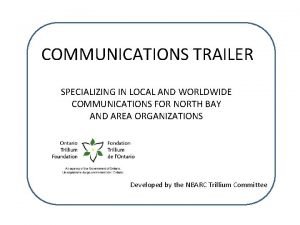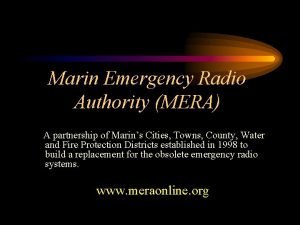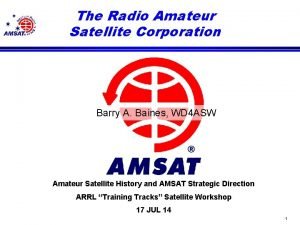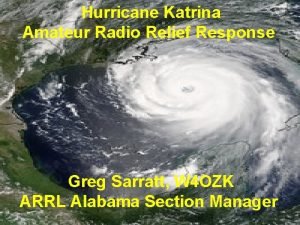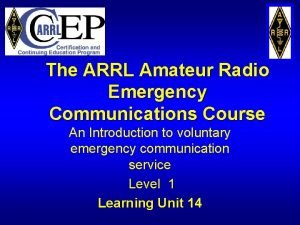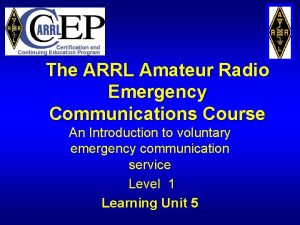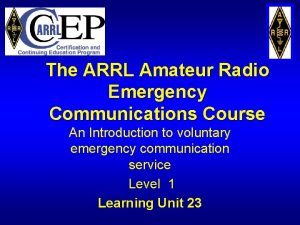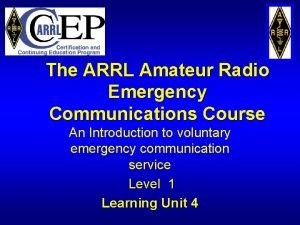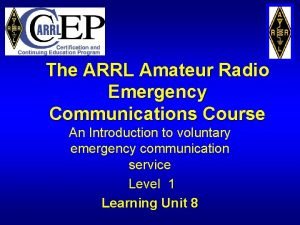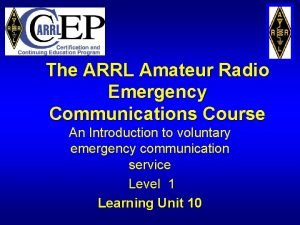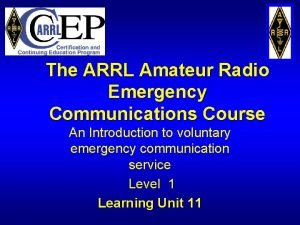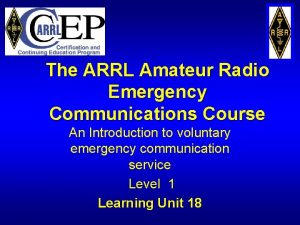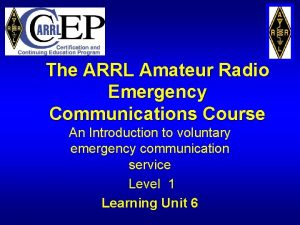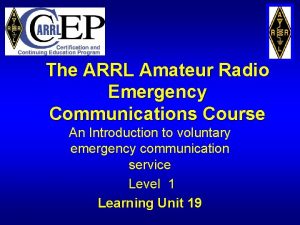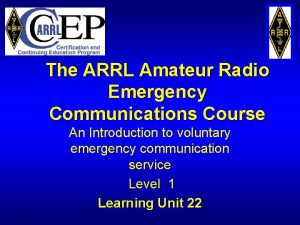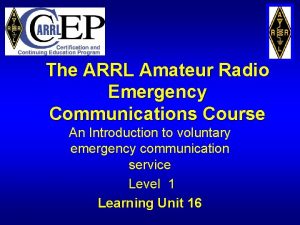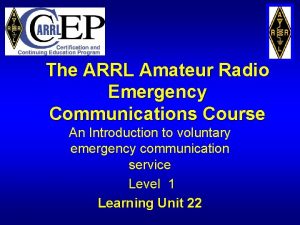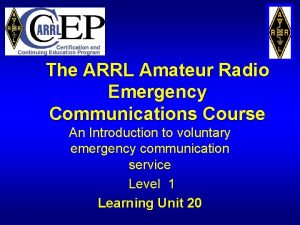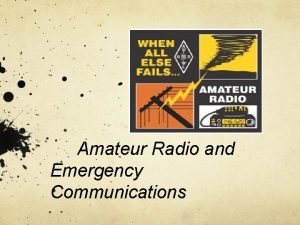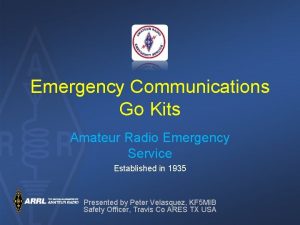The ARRL Amateur Radio Emergency Communications Course An


































- Slides: 34

The ARRL Amateur Radio Emergency Communications Course An Introduction to voluntary emergency communication service Level 1 Learning Unit 12

Preparing for Deployment Learning Unit 12 Objectives: In this lesson we will discuss the steps an emcomm volunteer should take to be ready to respond quickly, and be fully prepared to handle their emcomm assignment.

Preparing for Deployment Learning Unit 12 Student preparation required: None

Prepared for What? Remember the Boy Scout motto, "Be Prepared"? Nearly one hundred years ago, a young British Boy Scout asked Sir Robert Baden-Powell, the founder of Scouting, what exactly it was he should be prepared for. B-Ps famous answer was, "Why, for any old thing, of course!" The same should be true of emcomm volunteers. You never know which challenges an emergency situation will offer. You might have AC power, or just the batteries you bring along. Safe drinking water may be available, or you may have only your canteen. Sometimes you can find out in advance what sort of conditions are likely for your assignment, but many times no one will know -- particularly during the early stages of an emergency. Being prepared for an emergency communication deployment involves a wide range of considerations, including radio equipment, power sources, clothing and personal gear, food and water, information, and specialized training. No two deployments are the same, and each region offers its own specific challenges. What is appropriate for rural Minnesota in January probably won't work for urban southern California in any season.

Prepared for What? In this Learning Unit, our goal is to help you think about ways to be prepared for your particular situation. We cannot provide all the answers, but we can help you to ask the correct questions. Specific equipment choices are covered in the next Learning Unit.

Jump Kits The last thing you should need to do when a call for assistance comes is think of and locate all the items you might need. Any experienced emergency responder knows how important it is to keep a kit of the items they need ready to go at a moment's notice. This is often called a "jump kit" or "go kit. " Without a jump kit, you will almost certainly leave something important at home, or bring items that will not do the job. Gathering and packing your equipment at the last moment also wastes precious time. It is important to think through each probable deployment ahead of time, and the range of situations you might encounter.

Jump Kits Here a few basic questions you will need to answer: • Which networks will you need to join, and which equipment will you need to do so? • Will you need to be able to relocate quickly, or can you bring a ton of gear? • Will you be on foot, or near your vehicle? • Is your assignment at a fixed location or will you be mobile? • How long might you be deployed - less than 48 hours, up to 72 hours, or even a week or more? • Will you be in a building with reliable power and working toilets, or in a tent away from civilization? • What sort of weather or other conditions might be encountered? • Where will food and water come from? • Are sanitary facilities available? • Will there be a place to sleep?

Jump Kits • Do you need to plan for a wide variety of possible scenarios, or only a few? • Can some items do “double duty” to save space and weight? Other questions may occur to you based on your own experience. If you are new to emcomm or the area, consult with other members of your group for their suggestions. Most people seem to divide jump kits into two categories: one for deployments under 24 hours, and one for up to 72 hours. For deployments longer than 72 hours, many people will just add more of the items that they will use up, such as clothing, food, water, and batteries. Others may add a greater range of communication options and backup equipment as well. Everyone has their own favorite list of items to keep in a jump kit. While preparing this course material we looked at quite a few. Some were detailed, others more general. Some responders have more than one kit for different types of deployments. You will need to develop your own, suited to your own needs, but here is a general list to help you get started. Depending on your situation, you may not need some of the items on this list, or you may need special items not listed.

Jump Kit Idea List • Something to put it in -- one or more backpacks, suitcases, plastic storage tubs, etc. • Package individual items in zip lock bags or plastic kitchen containers

Radios and Accessories • Handheld VHF or dual-band radio (some people also like to bring a spare) • Spare rechargeable batteries for handhelds • Alkaline battery pack for handhelds • Alkaline batteries • Speaker mic and earphone for handhelds • Battery chargers, AC and DC for handhelds • Mobile VHF or dual-band radio • HF radio • Multi-band HF antenna, tuner, heavy parachute cord or nylon mason's twine. • VHF/UHF gain antennas and adapters (roll-up J-Pole, mobile magnetic mount, etc) • Coaxial feed lines, jumpers • Ground rod, pipe clamp, and wire

Radios and Accessories • AC power supplies for VHF/UHF mobile and HF radios, accessories. • Large battery source for VHF/UHF mobile and HF radios, with charger. • All related power, data, audio, and RF cables and adapters • Small repair kit: hand tools, multi-meter, connectors, adapters, fuses, key parts • Materials for improvisation: wire, connectors, small parts, insulators, duct tape, etc. • Photocopies of manuals for all equipment Headphones, for noisy areas and privacy with proper connector, adaptors • Specialized gear for packet, ATV or other modes • Multi-band scanner, weather radio • Personal cell phone, pager, spare batteries and chargers • Pencils, legal pads, pencil sharpener

Personal Gear • Clothing for the season, weather, and length of deployment • Toilet kit: soap, razor, deodorant, comb, toilet paper • Foul weather or protective gear, warm coats, hats, etc. as needed • Sleeping bag, closed-cell foam pad, pillow, ear plugs • High energy snacks • Easily prepared dried foods that will store for long periods • Eating and cooking equipment if needed • Water containers, filled before departure • First aid kit, personal medications and prescriptions for up to one week • Money, including a large quantity of quarters for vending machines, tolls, etc. • Telephone calling card

Information • ID cards and other authorizations • Copy of Amateur Radio license • Frequency lists and net schedules • Maps, both street and topographic • Key phone numbers, email and internet addresses • Contact information for other members in your group, EC, DEC, SEC, and others • Copy of emergency plans • Resource lists: who to call for which kinds of problems • Log sheets, message forms

Operating Supplies • Preprinted message forms • Log sheets or books • Standard forms used by the served agency • Letter or legal size notepads • Sticky notes • Paper clips and rubber bands • Blank envelopes • Stapler, spare staples

Sub-Dividing Your Kits You may want to divide your jump kit into smaller packages. Here are some ideas: • Quick deployment kit: hand-held radio kit, personal essentials, in a large daypack • VHF/UHF, HF kits for fixed locations • Accessory and tool kit • Emergency power kit • Short and long term personal kits in duffel bags • Field kitchen and food box in plastic storage tubs • Field shelter kit (tents, tarps, tables, chairs, battery/gas lights) in plastic storage tubs. You may not want to pre-pack some items for reasons of expense or shelf life. Keep a checklist of these items in your jump kit so that you will remember to add them at the last minute.

Pre-Planning When the time comes, you need to know where to go, and what to do. Having this information readily available will help you respond more quickly and effectively. It will not always be possible to know these things in advance, particularly if you do not have a specific assignment. Answering the following basic questions may help.

Pre-Planning • Which frequency should you check in on initially? Is there a "backup" frequency? • If a repeater is out of service, which simplex frequency is used for the net? • Which nets will be activated first? • Should you report to a pre-determined location or will your assignment be made as needed? Learn about any place to which you may be deployed to familiarize yourself with its resources, requirements, and limitations. For instance, if you are assigned to a particular shelter, you might ask your emcomm superiors to schedule a visit, or talk to others who are familiar with the site.

Pre-Planning • Will you need a long antenna cable to get from your operating position to the roof? • Are antennas or cables permanently installed, or will you need to bring your own? • Will you be in one room with everyone else, or in a separate room? • Is there dependable emergency power to circuits at possible operating positions?

Pre-Planning • Does the building have an independent and dependable water supply? • Is there good cell phone or beeper coverage inside the building? • Can you reach local repeaters reliably with only a rubber duck antenna, or do you need an antenna with gain? • If the repeaters are out of service, how far can you reach on a simplex channel? • Will you need an HF radio to reach the net? If you will be assigned to an EOC, school, hospital, or other facility with its own radio system in place, learn under what conditions you will be required or able to use it, where it is, and how it works. In addition to radios, consider copiers, computers, fax machines, phone systems and other potentially useful equipment. Consider escape routes. If you could be in the path of a storm surge or other dangerous condition, know all the possible routes out of the area. If you will be stationed in a large building such as a school or hospital, find the fire exits, and learn which parking areas will be the safest for your vehicle.

Training & Education This may sound a bit redundant since you are already taking this course, but it cannot be over-stressed -- the more you know, the more effective and valuable you will be. If the served agency offers emcomm volunteers job-specific training in areas related to communication, take it. Your emcomm managers should help you to learn how the served agency's organization works. Learn their needs and how you can best meet them. Work within your own emcomm organization to get any additional training or information you might need. For instance, The American Red Cross offers self-study or classroom courses in mass care, damage assessment, and other areas that either directly involve or depend upon effective communication. Many emergency management agencies offer additional training in areas such as radiological monitoring, sheltering, mass casualty response, and evacuation. The Federal Emergency Management Agency's Emergency Management Institute (http: //training. fema. gov/EMIWeb/) offers a wide range of courses, some of which may be related to your agency's mission.

Training & Education Your own group may offer general or agency-specific training in message handling and net operations under emergency conditions. If your group has its own equipment, it should offer opportunities for members to become familiar with its setup and operation in the field. On your own, set up and test your personal equipment under field conditions to be sure it works as expected. Participate in any drills or exercises offered in your area. Some are designed to introduce or test specific skills or systems, others to test the entire response. ARRL's Field Day and Simulated Emergency Test are two good nation-wide examples, but local organizations may have their own as well.

Review Pre-planning and physical preparation are essential to an effective and timely emergency response. Know in advance where are you are going, and what you will do when you get there. Keep a stocked and updated "jump kit" ready to go at a moments notice. Be sure your kit is adequate for the types of deployments you are most likely to encounter. Information is as important as equipment. Keep updated lists of other volunteers and contact information, frequencies, and other resources on hand as well as copies of all emcomm pre-plans.

Student Activity 1. Create a jump kit list suitable for your area and assignment. 2. Make a list of contacts and resources to keep in your jump kit.

Question 1 Of the following, which is the best reason for preparing a jump kit in advance? A. You will not leave something important at home or waste valuable time. B. You are spared the added expense of shopping for something after an emergency arises. C. You can be fully rested on the day of the emergency. D. You can test the batteries on your hand held VHF before leaving home.

Answer 1 Of the following, which is the best reason for preparing a jump kit in advance? A. You will not leave something important at home or waste valuable time.

Question 2 Which of the following would you omit from a jump kit prepared for a 12 -hour deployment? A. Hand held VHF or dual band radio. B. Spare rechargeable batteries for the hand held radio. C. High energy snacks. D. Camp cot and tent.

Answer 2 Which of the following would you omit from a jump kit prepared for a 12 -hour deployment? D. Camp cot and tent.

Question 3 Among the following, which are the most important items of information to include in your jump kit? A. ID cards and other authorizations. B. Field cookbook. C. Automobile repair manual. D. Instruction book for your chain saw.

Answer 3 Among the following, which are the most important items of information to include in your jump kit? A. ID cards and other authorizations.

Question 4 Among the following, which is the least important item of personal gear to include in your jump kit? A. Frequency lists and net schedules. B. Contact information for other members of your group, EC, DEC and SEC. C. Key phone numbers, email and Internet addresses. D. A deck of playing cards.

Answer 4 Among the following, which is the least important item of personal gear to include in your jump kit? D. A deck of playing cards.

Question 5 If you are assigned in advance to a particular location for emcomm operations, what is the least important thing to know in advance? A. The escape routes from the facility itself. B. The regular business hours maintained at the facility. C. The availability of radio equipment at the facility. D. The location of your operating position and the planned location of the antenna.

Answer 5 If you are assigned in advance to a particular location for emcomm operations, what is the least important thing to know in advance? B. The regular business hours maintained at the facility.

 Amateur radio digital communications
Amateur radio digital communications Amateur radio mesh network
Amateur radio mesh network Remote ham radio control
Remote ham radio control Chelmsford amateur radio society
Chelmsford amateur radio society Tonga amateur radio
Tonga amateur radio Chelmsford amateur radio society
Chelmsford amateur radio society Boulder amateur radio club
Boulder amateur radio club Chelmsford amateur radio society
Chelmsford amateur radio society Gartlin
Gartlin Emergency communications response vehicle
Emergency communications response vehicle National emergency communications plan
National emergency communications plan Cisa ecd
Cisa ecd Travelplus for repeaters
Travelplus for repeaters Logbook of the world download
Logbook of the world download Arrl radiogram
Arrl radiogram Arrl grounding and bonding
Arrl grounding and bonding Arrl field day rules
Arrl field day rules Arrl logbook
Arrl logbook Arrl radiogram
Arrl radiogram Atc communications and radio procedures
Atc communications and radio procedures Emergency communication trailer
Emergency communication trailer Marin emergency radio authority
Marin emergency radio authority Conventional radio system
Conventional radio system Amateur sdx
Amateur sdx M.vk amateur
M.vk amateur Telescopio amateur
Telescopio amateur Random amateur
Random amateur Japanese amateur jc
Japanese amateur jc Amateur revenge porn
Amateur revenge porn New york state amateur hockey association
New york state amateur hockey association Club lust production
Club lust production Teacher and student amateur
Teacher and student amateur Amateur sp
Amateur sp Signalink usb occasion
Signalink usb occasion Katrina amateur
Katrina amateur


